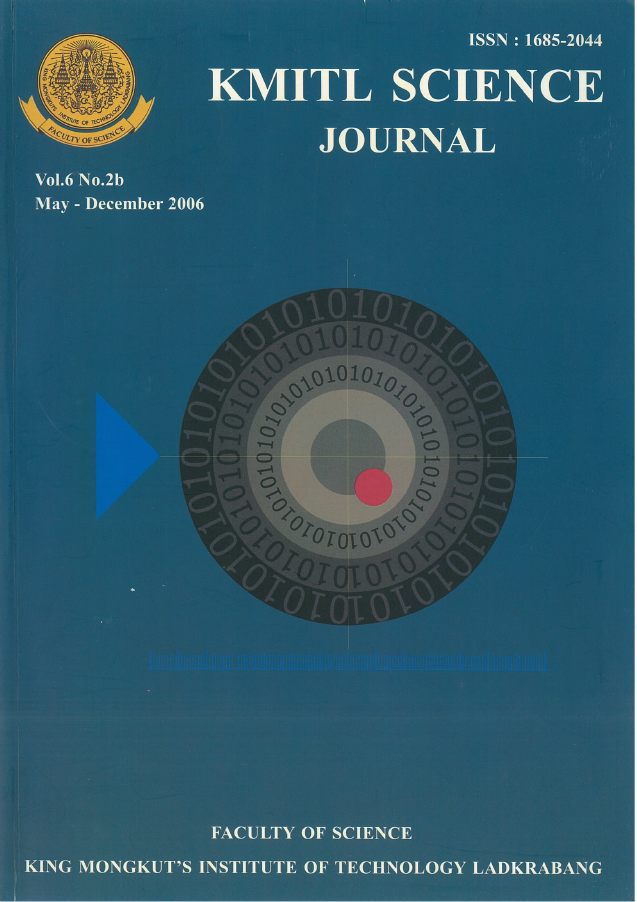Improvement of Functionalities of Soymilk Residue Protein by Papain Hydrolysis
Main Article Content
Abstract
Protein was extracted at pH 9 from fresh soy milk residue (okara) received from soy milk factory, and was modified by papain hydrolysis was done at the concentration of 1 gm of enzyme per 100 gm of protein and incubated for 30, 60 and 90 mins The electrophoresis pattern showed a decrease in molecular size of the proteins by the enzyme hydrolysis. Surface hydrophobicity of papain modified okara protein was significantly increased with increase in reaction time. This indicated the unfolding of the molecule. The poor solubility of okara protein was clearly improved by partially hydrosis with papain, particularly at 90 min. Other functionalities such as emulsion activity and foaming properties of okara protein were also enhanced by papain hydrolysis.
Keywords: soy protein, okara
Corresponding author: E-mail: cayongyuth@yahoo.com
Article Details
Copyright Transfer Statement
The copyright of this article is transferred to Current Applied Science and Technology journal with effect if and when the article is accepted for publication. The copyright transfer covers the exclusive right to reproduce and distribute the article, including reprints, translations, photographic reproductions, electronic form (offline, online) or any other reproductions of similar nature.
The author warrants that this contribution is original and that he/she has full power to make this grant. The author signs for and accepts responsibility for releasing this material on behalf of any and all co-authors.
Here is the link for download: Copyright transfer form.pdf
References
[2] Ma, C.-Y., Lui, W.-S., Kwok, K.C. and Kwok, F. 1997. Isolate and Characterization of Protein from Soy Milk Residue (Okara). Food Research International. 29(8): 799-805.
[3] Supichayangkul, N. 2002. Extraction and Characterization of Okara Protein Isolate. Thesis. King Mongkut’s Institute of Technology, Bangkok, Thailand.
[4] Hudson, B.J.F. 1992. Modification of Food Protein by Enzymatic Method. London: E A S.
[5] Kinsella, J.E. 1976. Functional Properties of Protein in Food: a Survey. Critical Reviews in Food Science Nutrition. 7: 219-280.
[6] Chan, W.M. and Ma, C.Y. 1999. Acid Modification of Proteins from Soymilk Residue (Okara), Food Research International. 32: 119-127.
[7] Harmada, J.S. and Marshall, W.E. 1989. Preparation and Functional Properties of Enzymatically Deamidated Soy Protein, Journal of Food Science. 54: 598-601.
[8] Achouri, A., Zhang, W. and Shiying, X. 1998. Enzymatic Hydrolysis of Soy Protein Isolate and Effect of Succinylation on the Functional Properties of resulting Protein Hydrolysates. Food Research International. 31: 617-623.
[9] Ortiz, S.E.M. and Wagner, J.R. 2002. Hydrolysates of native and modified soy protein isolates: structural characteristics, solubility and foaming properties. Food Research International. 35: 511-518.
[10] Nakai, S. and Modler, H.W. 1996. Food proteins – Properties and Characterization. New York.
[11] Nakai, S. and Powerie, W.D. 1997. Emulsifying Properiea of Protein. In Zayas, F.J. Ed. Functionality of Proteins in Food. Springer- Veriag, Berlin, Heidelberg, Germany.
[12] Laemmli U.K. 1970. Cleavage of Structural Proteins During the Assembly of the Head of Bacteriophage T. Nature. 227: 680-685.
[13] Voutsinas, L.P., Cheung. E. and Nakai,, S. and S. 1983. Relationships of Hydrophobicity to Emulsifying Properties of Heat Denatural Proteins. Journal of Food Science. 48 : 26-32.
[14] Pearce and Kinsella 1978. Emulsifying Properties of Protein: Evaluation of a Turbidimetric Technique. Journal of Agricultural and Food Chemistry. 26: 716-723.
[15] Phillips, L.G. Haque, Z. and Kinsella, J.E. 1987. A Method for the Measurement of Foam Formation and Stability. Journal of Food Science. 52(4): 1074-1077.
[16] Sathe, S.K., Lilley, G.G., Mason, A.C. and Weaver, C.M. 1987. High-Resolution Sodium Dodecyl Sulfate Polyacrylamide Gel Electrophoresis of Soybean (Glycine max L.) Seed Protein. Cereal Chemistry. 64: 380-384.
[17] Honig, H. and Wolf, W.J. 1991. Phytate-Miniral-Protein Composition of Soybean: Gel Filtration Studies of Soybean Meal Extract. Journal of Agricultural and Food Chemistry. 39: 1037-1042.
[18] Mahmoud, M. I. 1994. Physicochemical and functional properties of protein hydrolysates in nutritional products. Journal of Food Science. 59: 89-95.
[19] Govindaraju, K. and Srinivas, H. 2004. Studies on the effects of enzymatic hydrolysis on functional and physico-chemical properties of arachin. Food Science and Technology. 56: 183-191.
[20] Kinsella, J.E. and Shetty, K.J. 1979. Chemical Modification for Improving Functional Properties of Plants and Yeast Proteins. American Chemical Society. 92: 37-64.
[21] Were, L., Hettiarachchy, N.S. and Kalapathy, U. 1997. Modified Soy Proteins with Improved. Foaming and Water Hydration Properties. Journal of Food Science. 52: 821-823.


